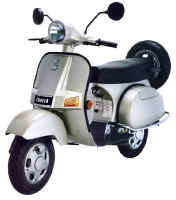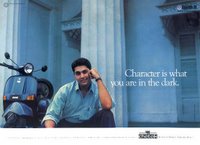Bajaj XCD was launched in September 2007. The brand was expected to boost the fortune of Bajaj Auto and intended to give nightmares to the market leader Hero Honda.

XCD was a 125 cc motorcycle planned by Bajaj to pip the largest selling motorcycle brand Splendour. Indian twowheeler market is dominated by the 100 cc segment which constitutes around 60% of the total volume sold. Bajaj so far was not able to come out with a brand worthy of competing with Splendour . Its major challenger brand Discover , although was moderately successful failed to dethrone the Splendour.
XCD 125 was launched with much hype and fanfare. After Pulsar, everyone had high expectations over new product launches from Bajaj.
The launch ad for XCD 125 was a hi-fi ad which frankly I did not understand. The ad seemed to be expensive with lot of digital effects but conveyed nothing. May be the company wanted to position the brand as a hi-tech brand.
watch the launch ad here :
XCD launch adThen came the down-to -earth campaigns for XCD. These campaigns were highly popular . The ads had two characters meeting at different places and the non-XCD owner getting pissed off at all these encounters.
Watch the campaigns here :
XCD- Traffic signal XCD Basement
XCD ShowroomThe traffic signal advertisement was the most popular one and was really a cool ad. The characters were so popular that Sun Direct Digital TV used the same characters and theme for their commercial - watch here :
sun direct During this phase , XCD directly pitched against 100 cc bikes. Bajaj forecasted that over a period of time, 100 cc bikes will be replaced by more powerful 125 cc bikes. Since Bajaj had earlier failed to foresee the shift of consumer from scooters to motorcycles, it did not wanted the history to repeat itself.
So in a pre-emptive move, Bajaj launched the 125 cc brand XCD ahead of Hero Honda.
Hence, during the launch phase, Bajaj tried to convince the potential 100 cc bike customers to switch to 125 cc. These customers were in the middle-class segment and the price of these bikes were in the range of Rs 40,000- Rs 45,000.
In the campaigns, XCD tried to tell the consumers that 125 cc bikes are more powerful , fuel efficient and had lot of features like electronic start, LED lamps and digital speedometers that 100 cc bikes does not have.
More over the brand had the legendary DTS-Si engine which was proprietary technology from Bajaj.
Despite all these, the XCD failed to take-off. The company expected XCD to even overtake Pulsar interms of the sales volume. But after the initial spike, XCD failed to enthuse the market.
The first reason was the product failure. Immediately after the launch, there were reports on product problems and recall. Although there was no PR disaster, consumers were taken aback by the newspaper reports. (
report) The product also failed to deliver on the expectations generated by the advertisements regarding the mileage.
Another significant reason was the positioning issue. Bajaj XCD was destined to fight with Splendour . So through out the campaign , it wanted to establish the Points of Parity with Splendour and other 100 cc bikes.
But contrary to Bajaj's expectations, the consumers established Points of Parity of XCD with Pulsar. The main culprit was the ingredient brand DTS-Si. Since Bajaj XCD also had the DTSi technology, consumers expected the same level of performance with that of Pulsar.
Also consumers never put XCD 125 in the same category as 100 cc. Hence the comparison was with higher CC brands like Pulsar. Since XCD was no where near Pulsar, obviously consumers never was happy. Bajaj wanted to do a break-away positioning but the strategy failed.
Bajaj also confused the consumers by launching Platina 125 DTSI. Platina is the entry level brand and launching that brand with 125 cc engine killed any remaining prospect of XCD 125, since there is not much difference between the two brands except the price.
In 2009, Bajaj is trying a second luck with the XCD brand. In January , the company launched XCD 135 DTS-Si. The new variant is touted as India's first commuter sports bike.
The brand is currently running a television commercial in all channels :
Watch it hereIn my personal opinion, it is a lousy commercial which is a sheer waste of money. It is totally absurd and the idea is nothing new. I think some other brand had earlier advertised about the " one pillion rider " theme. Two girls fighting for a pillion ride is not a big ' aha' and the ad is too lengthy one which is a waste of money at this time of cash-crunch.
Here again Bajaj is trying to create a new category of bikes. The new XCD boasts of 5 speed gear box, front disc brakes, digital speedometers etc which is seen on the premium bikes. XCD also is powered with DTS-SI engine and is priced at Rs 45,000.
I don't think that Bajaj has learned from the mistakes from the failure of XCD 125. Here again the positioning of XCD is strikingly similar to Pulsar. Now the only difference between Pulsar and XCD is interms of engine power and price. Even the styling has become almost the same.
XCD 135 brand is again creating points of parity with Pulsar .I am sure that XCD will not match the power of Pulsar and those customers who expect the Pulsar's qualities in XCD are bound to be disappointed.
I don't understand why Bajaj has not been able to create a seperate identity for XCD rather than
keep its association with Pulsar. The advertising agency has also done the damage of creating a campaign which is strikingly similar to Pulsar campaigns by including the famous stunt called Stoppie where the biker lifts the rear wheel and balances using the front. .These stunts and visuals were trademarks of Pulsar ads.
Bajaj is also ignoring its best-selling Pulsar brand . It was not able to create new memorable campaigns for the flagship Pulsar and now they are messing up Pulsar by using same positoning platform for other bikes.
I have a feeling that Bajaj is now panicking because of the comeptition from Yamaha and Honda. In the Panic, it is creating strategies to boost short-term sales rather than investing for the long term. Brands take time to establish but Bajaj is trying to do things fast.
Having said that, the most important determinant of success in the two-wheeler segment is the product's performance. Splendour has been ruling the Indian roads on pure performance than anything else. If XCD 135 is able to create new benchmarks for performance, then there is nothing that can stop it from becoming successful - even lousy positioning cannot block its success.
Related Brand
Pulsar Brand Update on Pulsar
 Although Vespa had a different image compared to its rival Bajaj, the brand was never considered to be lifestyle oriented. Consumers considered it as a stylish scooter and the image ended with that.
Although Vespa had a different image compared to its rival Bajaj, the brand was never considered to be lifestyle oriented. Consumers considered it as a stylish scooter and the image ended with that. total confusion resulting in the focus on the cubic capacity rather than the brand benefits resulted in the death of this brand. Bajaj later diluted the core positioning of the brand by launching a 125 version of Platina which again cannibalized XCD.
total confusion resulting in the focus on the cubic capacity rather than the brand benefits resulted in the death of this brand. Bajaj later diluted the core positioning of the brand by launching a 125 version of Platina which again cannibalized XCD. the customer. I had written about the stiff pricing of Kristal which may have caused the pathetic response from the customers. Kristal was a half-hearted attempt which was visible in the way this brand was promoted. After the initial promotions, there was no voice for the brand. It was a brand crafted for failure.
the customer. I had written about the stiff pricing of Kristal which may have caused the pathetic response from the customers. Kristal was a half-hearted attempt which was visible in the way this brand was promoted. After the initial promotions, there was no voice for the brand. It was a brand crafted for failure. ched in the Indian market in 2001 changed the fortunes of Bajaj Auto. With its " Definitely Male " positioning and superior performance, the bike crafted a segment of ' performance bike' in the Indian market. Even after all these years, Pulsar has maintained significant leadership in the 150CC + market.
ched in the Indian market in 2001 changed the fortunes of Bajaj Auto. With its " Definitely Male " positioning and superior performance, the bike crafted a segment of ' performance bike' in the Indian market. Even after all these years, Pulsar has maintained significant leadership in the 150CC + market.


 Bajaj is the pioneer in this market with a market share of almost 95%. Auto which is the short form of Autorickshaw started off with a front engine model with 'Dolby Digital ' sound effects with petrol smoke which comes free. In 1977 Bajaj launched the rear engine Auto which bought some decency to this class of vehicle.
Bajaj is the pioneer in this market with a market share of almost 95%. Auto which is the short form of Autorickshaw started off with a front engine model with 'Dolby Digital ' sound effects with petrol smoke which comes free. In 1977 Bajaj launched the rear engine Auto which bought some decency to this class of vehicle. eler segment is witnessing competition from other players and the Tata motors have launched a Blockbuster product TATA ACE to take on the three wheeler goods carrier.
eler segment is witnessing competition from other players and the Tata motors have launched a Blockbuster product TATA ACE to take on the three wheeler goods carrier.
 orse". With reasonable price and the low maintenance cost made this product a huge hit among the middle class Indians.
orse". With reasonable price and the low maintenance cost made this product a huge hit among the middle class Indians. ey made a mistake in leaving the scooter segment completely. Contrary to expectation, the scooter segment has not died. It has only changed.
ey made a mistake in leaving the scooter segment completely. Contrary to expectation, the scooter segment has not died. It has only changed. enthusiasm of majority of bikers.
enthusiasm of majority of bikers.